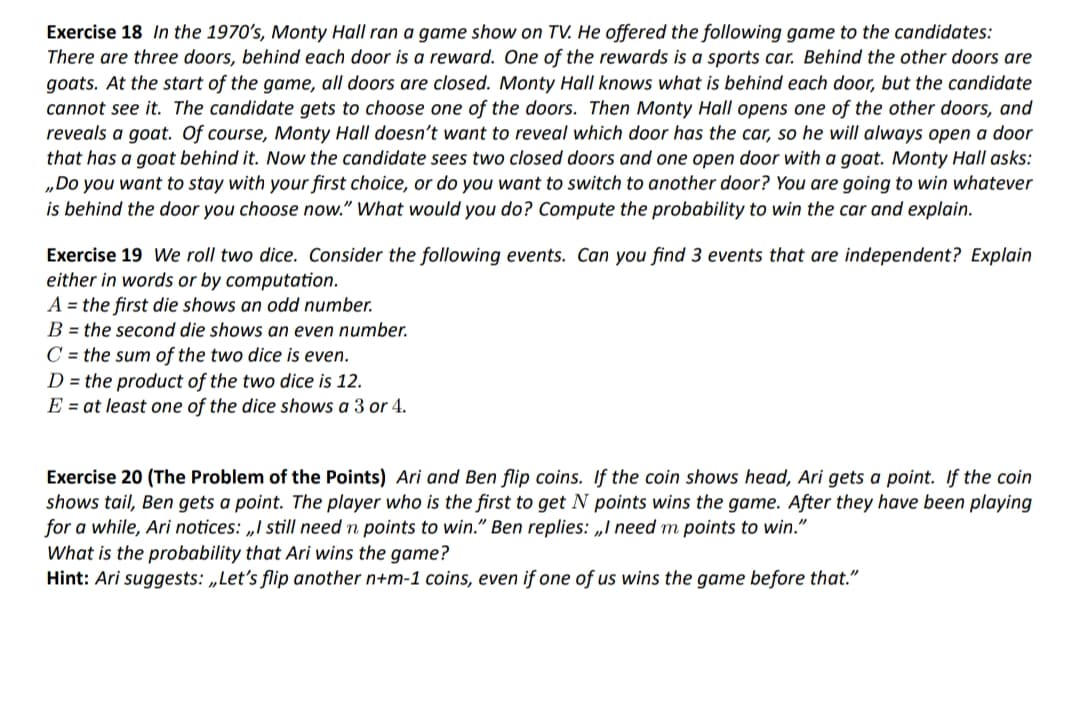Exercise 18 In the 1970's, Monty Hall ran a game show on TV. He offered the following game to the candidates: There are three doors, behind each door is a reward. One of the rewards is a sports car. Behind the other doors are goats. At the start of the game, all doors are closed. Monty Hall knows what is behind each door, but the candidate cannot see it. The candidate gets to choose one of the doors. Then Monty Hall opens one of the other doors, and reveals a goat. Of course, Monty Hall doesn't want to reveal which door has the car, so he will always open a door that has a goat behind it. Now the candidate sees two closed doors and one open door with a goat. Monty Hall asks: „Do you want to stay with your first choice, or do you want to switch to another door? You are going to win whatever is behind the door you choose now." What would you do? Compute the probability to win the car and explain.
Exercise 18 In the 1970's, Monty Hall ran a game show on TV. He offered the following game to the candidates: There are three doors, behind each door is a reward. One of the rewards is a sports car. Behind the other doors are goats. At the start of the game, all doors are closed. Monty Hall knows what is behind each door, but the candidate cannot see it. The candidate gets to choose one of the doors. Then Monty Hall opens one of the other doors, and reveals a goat. Of course, Monty Hall doesn't want to reveal which door has the car, so he will always open a door that has a goat behind it. Now the candidate sees two closed doors and one open door with a goat. Monty Hall asks: „Do you want to stay with your first choice, or do you want to switch to another door? You are going to win whatever is behind the door you choose now." What would you do? Compute the probability to win the car and explain.
Glencoe Algebra 1, Student Edition, 9780079039897, 0079039898, 2018
18th Edition
ISBN:9780079039897
Author:Carter
Publisher:Carter
Chapter10: Statistics
Section10.6: Summarizing Categorical Data
Problem 13CYU
Related questions
Topic Video
Question

Transcribed Image Text:Exercise 18 In the 1970's, Monty Hall ran a game show on TV. He offered the following game to the candidates:
There are three doors, behind each door is a reward. One of the rewards is a sports car. Behind the other doors are
goats. At the start of the game, all doors are closed. Monty Hall knows what is behind each door, but the candidate
cannot see it. The candidate gets to choose one of the doors. Then Monty Hall opens one of the other doors, and
reveals a goat. Of course, Monty Hall doesn't want to reveal which door has the car, so he will always open a door
that has a goat behind it. Now the candidate sees two closed doors and one open door with a goat. Monty Hall asks:
„Do you want to stay with your first choice, or do you want to switch to another door? You are going to win whatever
is behind the door you choose now." What would you do? Compute the probability to win the car and explain.
Exercise 19 We roll two dice. Consider the following events. Can you find 3 events that are independent? Explain
either in words or by computation.
A = the first die shows an odd number.
B = the second die shows an even number.
C = the sum of the two dice is even.
D = the product of the two dice is 12.
E = at least one of the dice shows a 3 or 4.
Exercise 20 (The Problem of the Points) Ari and Ben flip coins. If the coin shows head, Ari gets a point. If the coin
shows tail, Ben gets a point. The player who is the first to get N points wins the game. After they have been playing
for a while, Ari notices: „I still need n points to win." Ben replies: „I need m points to win."
What is the probability that Ari wins the game?
Hint: Ari suggests: „Let's flip another n+m-1 coins, even if one of us wins the game before that."
Expert Solution
This question has been solved!
Explore an expertly crafted, step-by-step solution for a thorough understanding of key concepts.
Step by step
Solved in 3 steps

Knowledge Booster
Learn more about
Need a deep-dive on the concept behind this application? Look no further. Learn more about this topic, probability and related others by exploring similar questions and additional content below.Recommended textbooks for you

Glencoe Algebra 1, Student Edition, 9780079039897…
Algebra
ISBN:
9780079039897
Author:
Carter
Publisher:
McGraw Hill

Algebra & Trigonometry with Analytic Geometry
Algebra
ISBN:
9781133382119
Author:
Swokowski
Publisher:
Cengage


Glencoe Algebra 1, Student Edition, 9780079039897…
Algebra
ISBN:
9780079039897
Author:
Carter
Publisher:
McGraw Hill

Algebra & Trigonometry with Analytic Geometry
Algebra
ISBN:
9781133382119
Author:
Swokowski
Publisher:
Cengage


Big Ideas Math A Bridge To Success Algebra 1: Stu…
Algebra
ISBN:
9781680331141
Author:
HOUGHTON MIFFLIN HARCOURT
Publisher:
Houghton Mifflin Harcourt

Holt Mcdougal Larson Pre-algebra: Student Edition…
Algebra
ISBN:
9780547587776
Author:
HOLT MCDOUGAL
Publisher:
HOLT MCDOUGAL